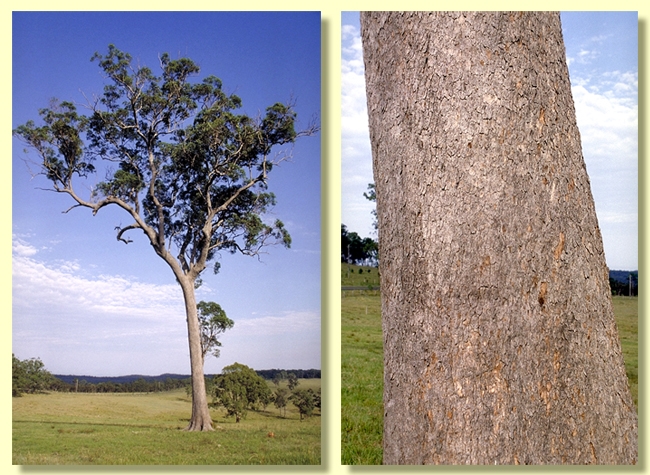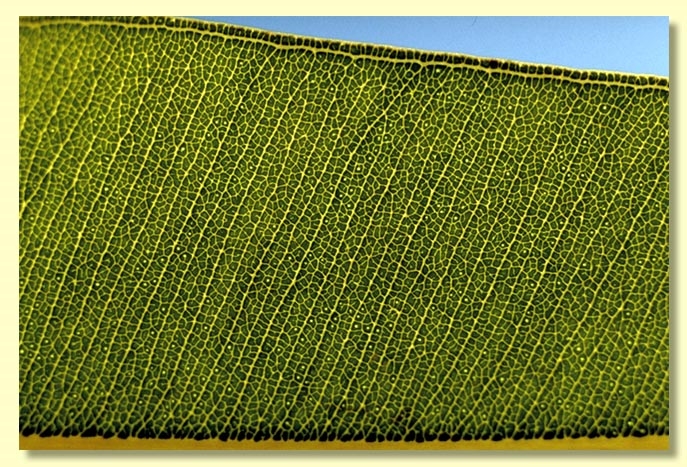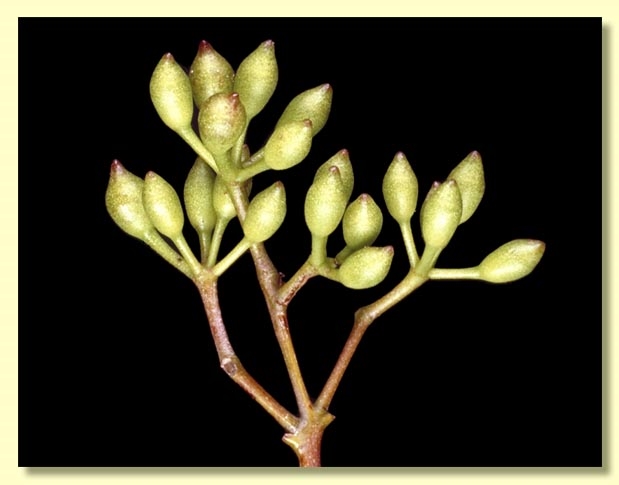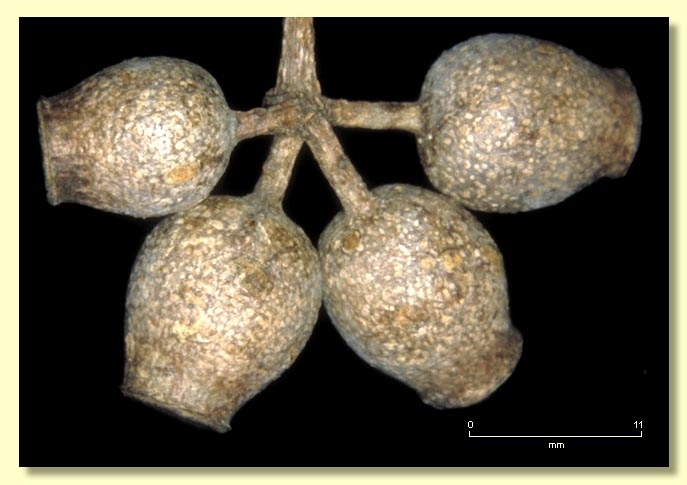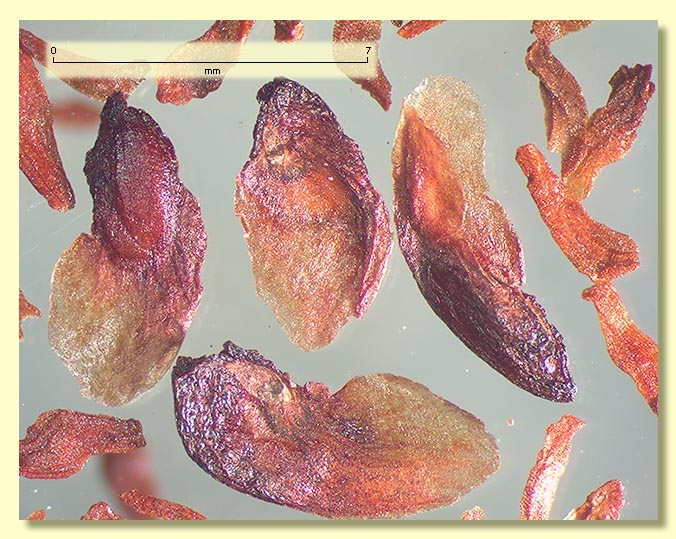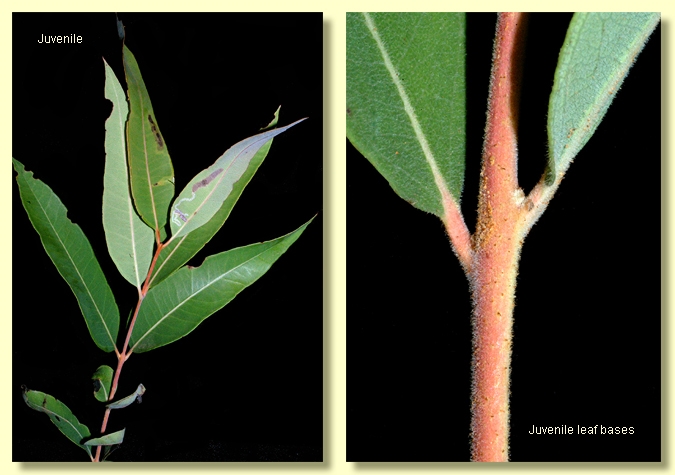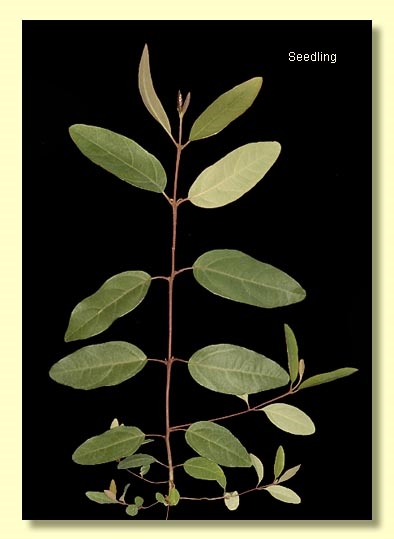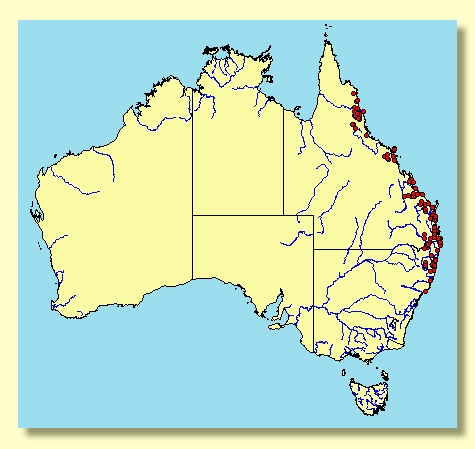Euclid - Online edition
Corymbia intermedia
Corymbia | Rufaria
Eucalyptus gummifera var. intermedia (R.T.Baker) Domin, Biblioth. Bot. 89: 469 (1928); E. intermedia R.T.Baker, Proc. Linn. Soc. New South Wales 25: 674 (1901); T. Ballina, NSW, W.Bäuerlen 314; lecto: NSW, fide S.T.Blake, Austral. J. Bot. 1: 261 (1953).
Bark rough and tessellated to the small branches, often thick and furrowed, grey or brown.
Juvenile growth (coppice or field seedlings to 50 cm): stem rounded in cross-section, scabrid at first, becoming smooth; juvenile leaves always petiolate, peltate for ca 10 nodes, opposite for 3 to 7 nodes then sub-opposite to alternate, lanceolate, 8–16 cm long, 2–4.2 cm wide, base of lower leaves peltate, eventually tapering to petiole, discolorous, green, scabrid at first particularly on petiole and midrib, eventually smooth.
Adult leaves alternate, petiole (0.8)1.2–2.5 cm long; blade lanceolate, 8–15 cm long, 1.3–4 cm wide, base tapering to petiole, discolorous, glossy or dull, green, strongly penniveined, densely to very densely reticulate, intramarginal vein parallel to and just within margin, oil glands island or absent.
Inflorescence terminal compound, peduncles 1–2 cm long; buds 7 per umbel, pedicels 0.2–1.5 cm long. Mature buds pyriform to obovoid, 0.7–1 cm long, 0.4–0.6 cm wide, green to yellow or creamy, smooth, without ridges, scar absent (both opercula shed together at flowering), operculum conical to rounded to beaked, stamens inflexed, anthers cuboid or cuneate, versatile, dorsifixed, dehiscing by longitudinal slits (non-confluent), style long, stigma tapered or mop-like, locules 3 or 4, the placentae with ovules not arranged in distinct vertical rows. Flowers white.
Fruit pedicellate (pedicels 0.2–1.5 cm long), ovoid to barrel-shaped, the neck short, 1–2 cm long, 0.8–1.6 cm wide, appearing speckled, disc descending, valves 3 or 4, enclosed.
Seeds brown or reddish brown, (4)6.5–9(11) mm long, ellipsoidal with terminal wing, surface smooth, hilum close to one edge, ventral.
Cultivated seedlings (measured at ca node 10): cotyledons reniform to orbicular; stems rounded in cross-section, scabrid; leaves always petiolate with peltate insertion of petiole on lamina for at least 9 or 10 nodes, opposite for 3 to 7 pairs, sometime 15 pairs, then alternating, elliptic to ovate, 5.5–13 cm long, 2–5.5 cm wide, discolorous, dull, darker green above. Leaves scabrid on underside and petiole.
Flowering has beeen recorded in January, February, October, November and December.
A small to tall bloodwood tree common in coastal and subcoastal hills and ranges north from Gloucester in northern New South Wales extending northwards into Queensland as far as Cooktown on Cape York Peninsula, in forests on soils of moderate fertility and moderate rainfall. Corymbia intermedia is fully rough-barked, and has slightly glossy or dull adult leaves that are conspicuously paler on the underside, small smooth buds and ovoid to barrel-shaped fruit 0.8–1.6 cm wide with speckles on the smooth surface, and winged seeds. The lower juvenile leaves have a peltate leaf base and are slightly scabrid, the upper leaves becoming smooth and with normal petiole insertion higher up the stem.
Within the extensive range of C. intermedia there are many species of bloodwood that have discolorous leaves and rough bark. Of the more widespread species C. clarksoniana differs in having scurfy buds and generally a more inland distribution; C. trachyphloia has smaller fruit, wingless seeds and juvenile leaves always peltate and setose; C. polycarpa has manifestly scurfy buds and narrow barrel-shaped fruit much longer than wide; C. gummifera has strongly urceolate fruit and wingless seeds; C. nesophila has smaller fruit (0.6–1 cm wide) and sparsely setose juvenile leaves with lobed to rounded leaf-bases, or the leaf-bases sometimes peltate.
Other bloodwoods that have discolorous leaves and rough bark but with narrower geographic ranges near to or overlapping with that of C. intermedia are: C. stockeri (subsp. stockeri and subsp. peninsularis), which differ from C. intermedia in the very glossy narrow juvenile leaves that are setose on the underside and also their slightly smaller (0.8–1.3 cm wide) more urceolate fruit; C. hylandii, which also has narrow glossy but glabrous juvenile leaves and often smaller fruit (0.8–1.2 cm wide); C. rhodops which has flowers with cream stamens and conspicuous red ovary roof, and larger (1.2–2 cm wide) urceolate to barrel-shaped fruit; C. novoguinensis, which has very scurfy buds and is restricted to the northern Cape York Peninsula and Papua New Guinea; C. lamprophylla, which has very glossy adult and juveniles leaves and urceolate fruit of similar size to C. intermedia but with a thickish rim; and C. xanthope, restricted to the Rockhampton–Marlborough area and differing from C. intermedia particularly in the seedling stage, viz. the latter has peltate and setose seedling leaves for at least 9 nodes while C. xanthope lacks peltate leaf-bases (leaf-bases usually tapering) and is not setose beyond node three to seven. C. xanthope is restricted to serpentinite substrate on rising ground.
MORE ABOUT CORYMBIA
MORE ABOUT RED BLOODWOODS

